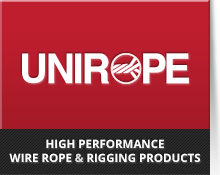Uni-Web® Polyester Boat Lifting Sling Capacities and Stock Codes
To order UNI-WEB® Boat Lifting Slings, please ask for our assistance. |
|
 |
|
| Single Ply Polyester | ||||
|---|---|---|---|---|
| Stock Code No. | Width inch | WLL lbs Main Eyes tapered or not (also with Triangles) Basket Hitch |
WLL lbs Main Eyes when using #SS6H TTRP Shackle Basket Hitch |
WLL lbs Extra Eye (with or without Hardware) Basket Hitch |
| BLS1-906 | 6 | 18,600 | 18,600 | 18,600 |
| BLS1-908 | 8 | 23,600 | 23,600 | 23,600 |
| BLS1-910 | 10 | 29,400 | 29,400 | 29,400 |
| BLS1-912 | 12 | 35,200 | 35,200 | 35,200 |
| Double Ply Polyester | ||||
|---|---|---|---|---|
| Stock Code No. | Width inch | WLL lbs Main Eyes tapered or not (also with Triangles) Basket Hitch |
WLL lbs Main Eyes when using #SS6H TTRP Shackle Basket Hitch |
WLL lbs Extra Eye (with or without Hardware) Basket Hitch |
| BLS2-906 | 6 | 33,000 | 33,000 | 18,600 |
| BLS2-908 | 8 | 45,500 | 45,500 | 23,600 |
| BLS2-910 | 10 | 48,000 | 48,000 | 29,400 |
| BLS2-912 | 12 | 60,000 | 48,000 | 35,200 |
| The following is a WARNING as published by the ‘Web Sling and Tie Down Association’ in their ‘Recommended Standard Specification for Synthetic Web Slings, WSTDA-WS-1, version 2004’: | |
|
5.3.5 Environments in which synthetic web slings are continuously exposed to ultraviolet light can affect the strength of synthetic web slings in varying degrees ranging from slight to total degradation. CAUTION: Degradation can take place without visible indications |
|
- Factors, which affect the degree of strength loss are:
- Length of time of continuous exposure.
- Web sling construction and design.
- Other environmental factors such as weather conditions and geographic location.
- Suggested procedures to minimize the affects of sunlight or ultra-violet light:
- Store web slings in a cool, dry and dark place when not being used for prolonged periods of time.
- Some visual indications of sunlight or ultra-violet degradation are:
- Bleaching out of web sling colour.
- Increased stiffness of web sling material.
- Surface abrasion in areas not normally in contact with the load.
- PROOF TESTING WARNING
Slings used in environments where they are subject to continuous exposure to sunlight or ultra violet light shall be proof tested to twice the rated capacity semi- annually, or more frequently depending on severity of exposure.



